Instructions for use
By purchasing "Fitosporin M", it is necessary to study the instructions for use for indoor plants. There are indicated the doses of the drug, methods of processing and methods of safe use of the drug.
Precautionary measures
If "Fitosporin" comes into direct contact with mucous membranes, it can provoke itching and slight irritation. Therefore, when working with the drug, you must follow the safety rules:
- Wear silicone gloves;
- During the processing period, it is not allowed to eat and drink, smoke;
- When spraying, use eye protection (goggles) and do not allow the product to enter the respiratory tract (wear a respirator or cloth mask). In the summertime, it is better to take the plant out of the room into the open air (but not in the sun!);
- Do not prepare drug solutions in food containers;
- If "Fitosporin" gets on the skin or mucous membranes, they are thoroughly washed with a stream of water;
- If it enters the stomach, rinse it, causing vomiting, and take activated charcoal tablets;
- After use, wash hands, face, neck with soap and water;
- Store the product in places where access for children and pets is difficult.
How to handle correctly
The bacteria-based product can be used for all types of indoor plants, including the effective "Fitosporin" for orchids. The main purposes of using the drug:
Instructions for use on the packaging
- Plant healing;
- Preventive treatment in order to prevent the occurrence of diseases;
- Seed soaking;
- Use for processing cuttings;
- Preparing the soil before planting seeds.
Important! If the plant needs salvation, since the disease is neglected, then chemical agents are more effective. The initial stages of diseases are amenable to treatment with "Fitosporin"
Indoor plants can be treated by watering the soil and spraying. Watering regime - monthly. For diseased plants, treatment should be carried out 2-3 times a week.
If "Fitosporin" is used for orchids, then there is a difference in how to use it for watering. The pot with the orchid is immersed in a large container filled with a solution of the drug, and after 15-20 minutes it is pulled out.
When resuscitating orchids, a solution of "Fitosporin" is prepared, the roots are immersed in it after washing and cutting off dead and decayed parts.
Soaking the seeds before planting also has a beneficial effect on disease prevention.
Important! "Fitosporin" is used in autumn and spring for preventive spraying of plants. Also, after using any chemicals for treatment, treatment with "Fitosporin" will be beneficial and quickly restore their microflora
Treatment of indoor plants "Fitosporin"
Dosage
For indoor plants it is not recommended to purchase "Fitosporin" in the form of powder or paste. They are intended more for use in orchards and vegetable gardens.
The correct dosage depends on the purpose of using the drug. Fundamental rules:
- "Fitosporin" in bottles: 10 drops per glass of water - preventive spraying and watering, 20 drops per glass of water - when treating diseased plants;
- Paste: 10 drops of concentrate (50% paste solution) per 1 liter of water - for spraying, 15 drops per 1 liter - for irrigation, 4 drops per 0.2 liters - soaking cuttings and seeds on the eve of planting (time - 2 hours. );
- Powder: 1.5 g per 2 l - prophylaxis, per 1 l - treatment during treatment.
There is no difference how to dilute Fitosporin specifically for orchid treatment. This is done in a similar way to other indoor plants.
Frostbite
Phalaenopsis belongs to plants that need to be kept in a warm regime, they can withstand a decrease in ambient temperature to + 16 ° C, however, prolonged exposure to these low rates can lead to the death of the plant.
Hypothermia of phalaenopsis can be stated if you notice the following signs: wet slippery spots are visible on the leaves, the appearance of which leads to further death of the leaf plate.
If you are sure that the phalaenopsis is frozen - what to do? If such spots have affected the entire plant, then it cannot be reanimated, but if individual parts of the leaf are damaged, you should try to help the flower:
- A part of the damaged sheet is cut off, the cut site is treated with coal powder or an antiseptic that does not contain alcohol;
- If a whole leaf is damaged, then it must be removed completely, while dividing it in half vertically and pulling on both ends of the leaf, carefully, without damaging the stem, then the stem is powdered with crushed coal or cinnamon.
Composition and action

Fitosporin is an excellent remedy for microbial and fungal diseases of tomatoes at all stages of their development and as a prophylaxis. A big plus is that the drug is completely safe for both insects and humans, so the bushes can be sprayed with it during flowering and during fruiting.
They can protect tomatoes from late blight in the open field and in greenhouses, and can be used to disinfect the soil in the fall after harvest and in the spring before planting seedlings.
The composition is as follows:
- spores of living bacteria Bacillus subtilis (Bacillus subtilis or hay bacillus) strain 26D, the amount of 100 million cells / g;
- powdered chalk as a binder;
- antibiotics of natural origin.
The composition of the phytosporin M preparation also includes humic acid, brown powder coal and additives containing important micro- and macroelements, vitamins, amino acids.
The following forms of phytosporin are presented on the market:
- gray-white powder, in bags from 10 to 300 g (1 tsp of the drug weighs 3.5 g);
- brown paste in plastic bags of 200 g;
- ready-made liquid (transparent, yellow-orange) in plastic bottles of 0.2 and 0.5 liters, cans of 1 and 5 liters.
The shelf life of the product is 3-4 years (indicated on the package) without loss of useful qualities.
Spraying with Phytosporin tomatoes and other crops will be effective against such diseases:
- late blight;
- alternaria;
- all types of spotting;
- root, stem and fruit rot;
- bacteriosis;
- bacterial cancer;
- powdery mildew, downy mildew and American mildew;
- scab;
- monolithic burn;
- rust;
- all types of mold;
- phomosis;
- fusarium;
- cercosporosis.
Efficiency of application ranges from 65% (during storage) to 95% - depending on the culture and the stage of plant damage. A big plus of the drug is that it does not lose its useful qualities either when frozen or at high temperatures (up to +42).
The advantages of phytosporin are as follows:
- the drug is non-toxic, safe, the fruits can be consumed immediately after processing, only it must be thoroughly washed;
- can be used at any stage of plant development: for processing tomato seeds, seedlings, during flowering, setting and ripening of fruits;
- long shelf life - up to 4 years;
- effective against almost all pathogenic microorganisms and fungi;
- increases resistance to adverse environmental factors;
- can be used simultaneously with fertilizers and growth regulators (best combined with zircon or epin);
- increases productivity;
- disinfects the soil under the bushes.
There is one drawback, or rather, a certain limitation of this drug - it cannot be used at any time of the day, since the bacteria of the hay bacillus die in bright sunlight.
Therefore, treatment with phytosporin in the morning will be ineffective, it is necessary to spray it in the evening or in cloudy weather, but not before the rain itself.For beneficial bacteria to start working, they need 2-3 hours to penetrate into plant tissue.
Phytosporin analogs - trichophyte, preparations Shining and Baikal M, Baktofit, Fitoftorin, Planriz, Arilin.
Fitosporin is the key to orchid health
Perhaps novice flower growers have heard that from time to time the roots of an orchid are treated with phytosporin, but they did not understand why this was done. In order to understand the issue, one should consistently understand why the drug is needed at all.
Fitosporin is a microbiological agent, in other words, a phytopreparation that has a protective effect on decorative flowers from the effects of "fungi" and bacteria.
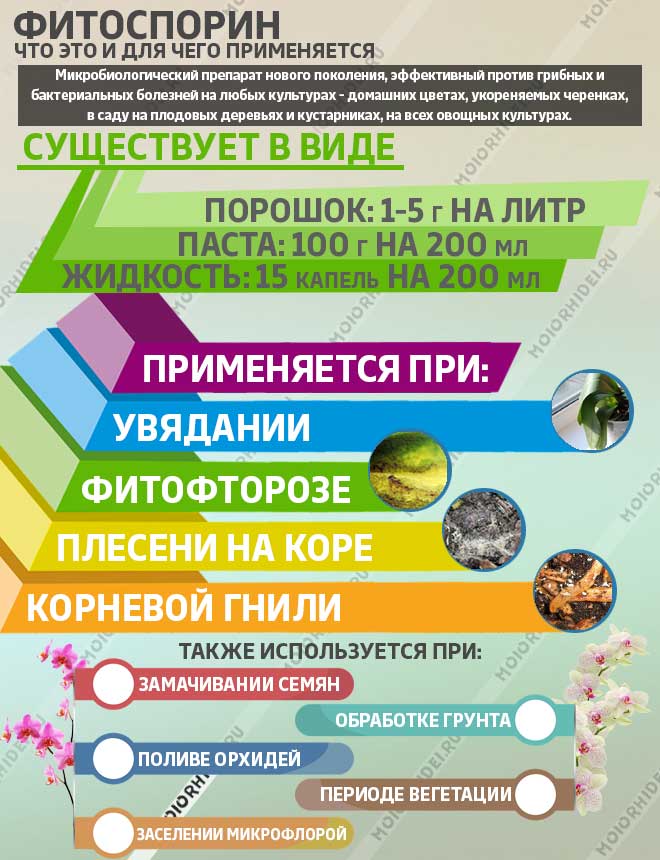
Phytosporin application infographics for orchids
The presented preparation consists of spores and live fractions of cells of the culture of Bacillus subtilis 26 D. The tool begins to work immediately after application.
In the role of the carrier of the active compound, a composition is used, which is prepared on the basis of chalk, other fillers, as well as OD-humate. The latter enhances the fungicidal effect of phytosporin, ensuring the stability of the effect obtained for a long time. That is why the drug can be stored for two years. The agent is low-hazard, so you don't have to worry that something wrong will happen to the orchids after processing.
Phytosporin can be found on sale in the following forms:
- powder;
- pasta;
- liquid, volume 110 ml.
True, this does not mean that the drug can be directly poured onto the flowers. He's going to get divorced. You can read the information on the application in the instructions.
It must be said that when we say "phytosporin", we do not necessarily mean this particular drug. Many imply means in which the main active ingredient is fractions of bacterial cultures. Although there are drugs with other cell strains, these include "Alirin" or "Gamair".
This is interesting: Soil for orchids - selection of the required composition of the earth
Orchid processing during flowering and possible mistakes
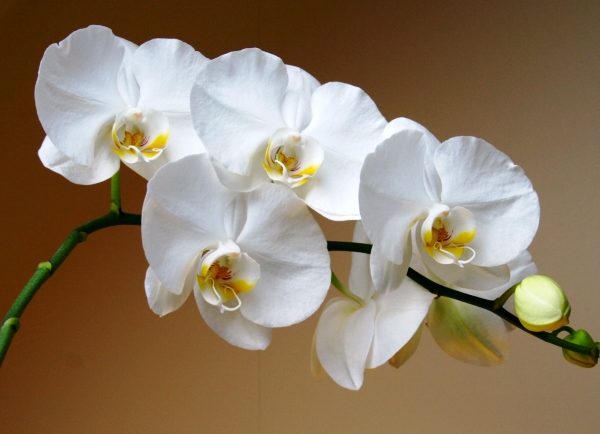
Can a blooming orchid be processed? Definitely yes. In general, there is no specific period for its application, it will not harm at any stage of plant growth. But just like that, for no apparent reason, you should not abuse Fitosporin.
It is necessary to deal with orchid processing if:
- rot formation is observed;
- blackleg;
- the plant withers;
- the appearance of late blight.
Customer reviews on the use of Fitosporin indicate that the drug has proven itself well both among flower growers and among gardeners. With proper use, orchids and Fitosporin will become inseparable.
The most suitable analogue can be called Trichodermin. It is used in the same cases for the same diseases as Fitosporin.
The drug successfully fights fusarium and powdery mildew. Its difference from Fitosporin is that it does not have organic substances and does not contain viable bacteria. This indicates that there is still no full-fledged analogue of Fitosporin.
It is very important to keep in mind which additives, fertilizers or medications Fitosporin can be combined with. They are produced in large quantities, here are just a few of them: This substance can be used in conjunction with plant growth stimulants, for example, with "Epin" and Zircon
If there is an alkali in the preparations that will be used in conjunction with Fitosporin, then it is better to use these substances separately
This substance can be used in conjunction with plant growth stimulants, for example, with "Epin" and Zircon. If there is alkali in the preparations that will be used in conjunction with Fitosporin, then it is better to use these substances separately.
The orchid is very popular among Russian flower growers. By providing competent and timely care, problems with orchids can be avoided.
As in humans, any disease in a plant must be treated as early as possible. In case of any deviation from the norm in the growth of orchids, you must immediately begin therapeutic treatment of your favorite flower. This will help the plant to cope with disease or parasites without harming the immune system, without the use of chemicals. Do not forget that timely prevention is the best treatment. Both in treatment and prevention, Fitosporin is the best helper in the fight against most diseases.
The preparation comes with instructions for use, which describe in detail all the subtleties of working with it. This allows the beginner to understand the use of the medication. Buyers will be pleased with the price of Fitosporin, and this cannot but please all lovers of orchids and other plants.
Prevention of all kinds of diseases is an eternal headache for indoor orchid lovers. For this, the ideal conditions of detention are created as possible, vitamin-mineral and amino acid supplements are used, spraying with antistressants and immunomodulators. Treatment with plant biosecurity agents may not be superfluous, among which Fitosporin-M is one of the most famous and effective. The proposed material will tell you how and against which orchid diseases to use this drug.
Orchid processing during flowering and possible mistakes

Can a blooming orchid be processed? Definitely yes. In general, there is no specific period for its application, it will not harm at any stage of plant growth. But just like that, for no apparent reason, you should not abuse Fitosporin.
It is necessary to deal with orchid processing if:
- rot formation is observed;
- blackleg;
- the plant withers;
- the appearance of late blight.
Customer reviews on the use of Fitosporin indicate that the drug has proven itself well both among flower growers and among gardeners. With proper use, orchids and Fitosporin will become inseparable.
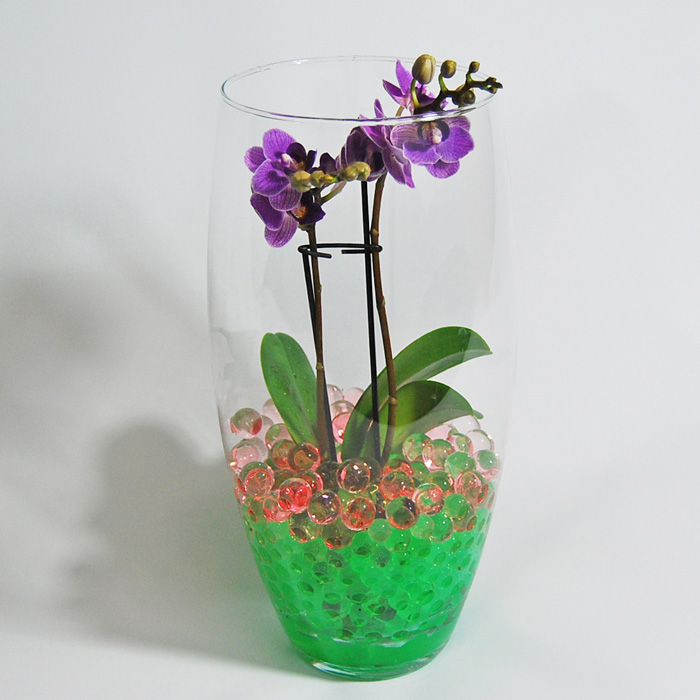 You may be interested in:
You may be interested in:
Orchid in a hydrogel: planting, growing and caring An orchid is a decorative flower that appeared on window sills not so long ago. Among the various species, the most ... Read more ...
The most suitable analogue can be called Trichodermin. It is used in the same cases for the same diseases as Fitosporin.
The drug successfully fights fusarium and powdery mildew. Its difference from Fitosporin is that it does not have organic substances and does not contain viable bacteria. This indicates that there is still no full-fledged analogue of Fitosporin.
Note! It is impossible to harm plants with phytosporin. It is indispensable in the prevention of diseases in orchids, it is useless for the most dangerous diseases.
It can be reused only after the primer is dry after the previous treatment.
It is very important to keep in mind which additives, fertilizers or medications Fitosporin can be combined with. They are produced in large quantities, here are just a few of them:
- Triallat;
- TMTD;
- Decis.
This substance can be used in conjunction with plant growth stimulants, for example, with "Epin" and Zircon. If there is alkali in the preparations that will be used in conjunction with Fitosporin, then it is better to use these substances separately.
The orchid is very popular among Russian flower growers. By providing competent and timely care, problems with orchids can be avoided.
As in humans, any disease in a plant must be treated as early as possible. In case of any deviation from the norm in the growth of orchids, you must immediately begin therapeutic treatment of your favorite flower. This will help the plant to cope with disease or parasites without harming the immune system, without the use of chemicals. Do not forget that timely prevention is the best treatment.Both in treatment and prevention, Fitosporin is the best helper in the fight against most diseases.
The preparation comes with instructions for use, which describe in detail all the subtleties of working with it. This allows the beginner to understand the use of the medication. Buyers will be pleased with the price of Fitosporin, and this cannot but please all lovers of orchids and other plants.
Indications for use and methods of use
For orchids, Fitosporin can be used to cope with plant diseases of a bacterial or fungal nature, such as spots of various kinds, powdery mildew, fusarium and other rot, bacterial cancer, late blight, septoria and others. But this remedy cannot be called a universal cure for all plant diseases. Its effectiveness, depending on the nature of the lesion, ranges from 65 to 95%.
The advantage of the drug is the ability to use it at any temperature. Processing them will be effective in the range from -50 to +40 degrees. It is useful for processing seed material before sowing and further at all stages of crop development up to adult plants.
If the processing conditions are unfavorable for the bacterial culture, which is the active basis of the drug, it turns into a spore state. If the external environment allows the use of the drug, the activity of the bacteria is resumed.
There is only one drawback in Fitosporin. Bright sunlight and alkaline environments are harmful to bacteria. Therefore, the treatment of orchids with it is carried out only during hours when there is no active sun. Cloudy, early morning or late evening is best suited for this. For processing, the plant is transferred to the bathroom. The frequency of procedures is 1 time per 30 days.
 Application options:
Application options:
- For soil treatment, diluted Fitosporin is poured onto the substrate. Another use is to soak the soil in a container with the prepared solution.
- For dressing seeds before germination. Sterile conditions are required to germinate the seed effectively. Even after disinfection of all utensils and tools, the infection can persist on the seeds. Soaking them in solution can prevent infection.
- For processing the root system before transplanting a plant for partial or complete resuscitation. Before processing, the root system is washed with clean water and all dead or rotted roots are cut off. Then the underground part of the orchid is soaked in the previously diluted Fitosporin, the sections are treated with crushed activated carbon and dried.
- You can spill a home orchid with a solution of the drug if the substrate is heavy and quickly absorbs moisture. If the soil is light, the pot is soaked in a container with a solution to prevent infection.
- Spraying foliage from a spray bottle with a fine spray is used in combination with other methods of using the drug.
What is it used for?
 Phytosporin rapidly spreads through the vascular system of plants. The basis of the drug is spores that secrete waste products. These products inhibit the development of fungal and bacterial diseases, and then completely destroy them. The product fights well the following pests:
Phytosporin rapidly spreads through the vascular system of plants. The basis of the drug is spores that secrete waste products. These products inhibit the development of fungal and bacterial diseases, and then completely destroy them. The product fights well the following pests:
- powdery mildew;
- root rot;
- fusarium;
- bacteriosis.
Fitosporin is an indispensable tool for lovers of the Orchid genus, but the effect depends on many factors. Often, the effectiveness ranges from 65% -95%.
The described drug is one of the low-toxic, therefore, processing can also be performed in residential premises - this does not threaten severe poisoning.
Description of the drug
Fitosporin is a microbiological preparation for combating bacterial diseases on plants of any crop: from tomatoes and apple trees to tropical indoor ones.
The basis of the preparation is hay bacillus (Bacillus subtilis), which is an antagonist against phytopathogens and begins to act immediately after the treatment of the plant. It produces fungicidal oligopeptides that inhibit the multiplication of plant pathogens.
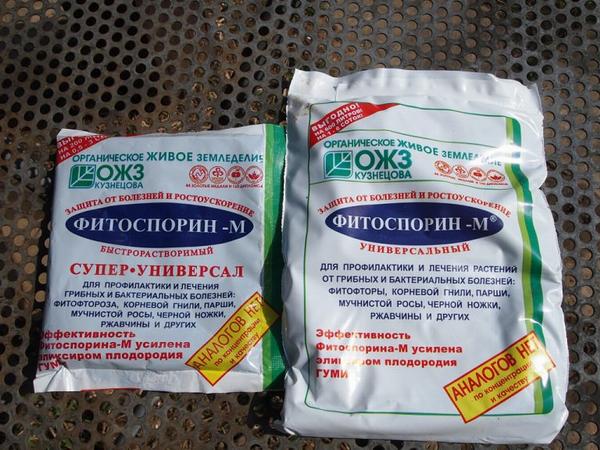
Forms of issue
- Powder (concentration more than 2 billion spores and living cells / g) in sachets weighing 10 and 30 g each;
- Paste (concentration more than 100 million spores and living cells / g), 200 g in a sachet;
- Liquid (concentration over 1 billion spores and living cells / g), in a 110 ml bottle.
Indications for use
Fitosporin is effective against a wide range of fungal and bacterial plant diseases, including powdery mildew, bacterial spot, bacterial cancer, fusarium (white, gray, black, dry, etc.) rot, septoria, brown rust, root rot, late blight and many others disease.
However, at the same time, phytosporin is not a universal remedy for all diseases. Depending on the type of plant and the extent of the disease, its effectiveness ranges from 65 to 95%.
Advantages and disadvantages
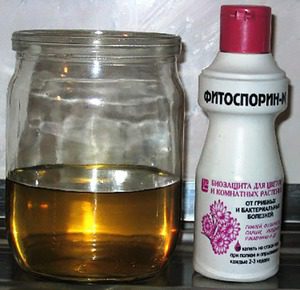 The main advantage is that the drug can be used at any temperature: from -50 to + 40 ° C, as well as at all stages of plant development: from seeds to mature trees.
The main advantage is that the drug can be used at any temperature: from -50 to + 40 ° C, as well as at all stages of plant development: from seeds to mature trees.
In unfavorable conditions, the bacterium, which is the basis of the drug, goes into a state of spore, while its vital activity is suspended. When conditions return to normal, the bacteria becomes active.
The disadvantage is that the bacterium dies in bright sunlight and in an alkaline environment. Therefore, phytosporin treatment should be carried out in cloudy weather, either early in the morning or in the evening.
Ways to use the drug
- Soil processing. The substrate is spilled with a solution of phytosporin, or it is soaked in a basin.
- Seed soaking. Orchid seeds need sterile conditions to germinate. Even if all work utensils are disinfected, the infection can get along with the seeds. To prevent this from happening, the seeds can be soaked in a phytosporin solution.
- Soaking roots. It is possible to soak the roots of an orchid in phytosporin during transplantation for prophylaxis or when a partial or complete resuscitation of the plant is carried out. At the same time, the living roots are washed, the dead areas are cut off with a disinfected tool and soaked in a container with a phytosporin solution. After the procedure, the slices are sprinkled with crushed coal or cinnamon and dried.
- Can I water an orchid with a drug? It makes sense to spill if the orchid grows in a fairly heavy, moisture-absorbing substrate. In other cases, if the substrate is very light, it is more useful to soak the pot with the plant in a bowl of solution. Usually this method is used to prevent disease.
- Leaf processing. Spraying with a fine spray is also an effective way of treating a plant. Most often, this method is used in combination with the others mentioned above. At the same time, it is highly desirable to use liquid phytosporin as a mother liquor.
This is interesting: Purple orchid - an overview of phalaenopisis varieties
How to apply: step by step instructions
The tool is used to treat not only the orchid itself, but the cuttings, as well as the soil before planting.
Dosage of paste and liquid
The dosage option depends on the appointment of Fitosporin:
- To spray orchids, mix the paste and water in equal proportions, and then add 1-2 drops of liquid Fitosporin there.
- For watering phalaenopsis, 15 drops of the fungicide are diluted in a liter of water (it is advisable to use boiled or settled water).
- To soak the shoots, 4 drops of paste are stirred in a glass of water.
- The bottled product is used as a preventive measure against diseases and pests, as well as for their control. In the first case, 4 drops are added to a glass of water, and in the second - 10 drops for the same volume of water.
How to dilute the powder to soak or spray a flower?
The powder dilution algorithm also depends on the goal pursued:
- Soaking the scions. 1.5 powder is added to 100 ml of water. The cuttings are left for 2 hours.
- From root rot. 2 tsp powder to dissolve in 5 liters of water. Leave the roots in the solution for 2 hours.
- From infections of a fungal and bacterial nature. 0.5 tsp mix with 2 liters of water. Spray phalaenopsis with a diluted product.
- To treat an orchid, 1.5 g of powder is poured with a liter of water and the culture is watered.
The ready-made solution cannot be stored for a long time. It is used within two hours after preparation.
How to process a plant?
If harmful microorganisms are found, the orchid is watered with a product consisting of 1.5 g of Fitosporin and 1 liter of water. It is necessary to choose a method of diving. For this:
- The solution is poured into a wide container in which the flowerpot will fit.
- The flower pot is left for half an hour.
- After 30 minutes, the plant is removed from the liquid and allowed to drain.
During soaking, the flowerpot ceases to be transparent. But after a couple of receptions, the shower container will return to its previous appearance.
How long should the flower be kept in solution?
It is not recommended to keep the orchid in the prepared solution for more than 30 minutes. This time is enough to destroy harmful organisms, but an increase in the exposure time threatens with an overabundance of spores in the plant.
When and what result should be expected?
The period for achieving the result depends on the problem, which is eliminated with the help of Fitosporin. If this is a pest attack, then at least 3, and sometimes 4 treatments will be needed.
In total, this will take up to 1.5 months. If it is a disease or a lack of nutrients, then it is possible to cope with the problem in 2 treatments.
Repeated procedure
The repeated procedure is carried out in 1.5-2 weeks.
- It is necessary to wait until the substrate is completely dry. Processing ends when all pests have been destroyed.
- Spraying can be carried out more often - once every 7 days.
Compatibility with other drugs
The use of the drug in combination with other drugs is safe. Phytosporin can be used to treat and prevent diseases and pests in conjunction with medications such as:
- Triallate (herbicide);
- Decis (insecticide);
- Fundazol, Vitivaks 200, TMTD, etc. (fungicides).
The compatibility of the product has been confirmed by laboratory tests, as well as by the experience of using it by owners of indoor flowers. Excellent compatibility rates are also observed with artificial plant growth regulators. The only contraindication is the use with drugs that increase the alkalinity of the soil.
FITOSPORIN-M: PROPERTIES, DOSAGE, PREPARATION OF THE SOLUTION, APPLICATION FOR ORCHIDS!
Treatment of orchid roots "Fitosporin-m"
Application methods for orchids
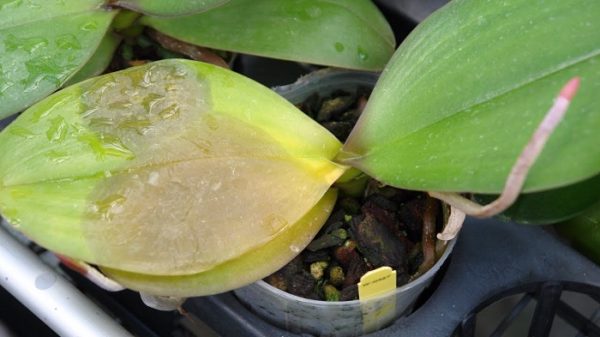
The drug is used to rid plants of parasites, to treat most plant diseases, for prophylaxis. The effectiveness of a substance directly depends on the severity of the disease and the time elapsed since the moment of infection. With a serious and advanced disease, without strong preparations containing chemicals in the composition, good results cannot be achieved. But even in this case, Fitosporin is useful and accelerates the rehabilitation process.
It has a positive effect on the immunity of the plant, which is very important after a serious illness.
When using Fitosporin M for orchids, the following unpleasant problems can be solved:
- scab;
- rotting roots;
- withering;
- late blight.
Experienced indoor plant lovers use Fitosporin before and during planting or transplanting. It is also irreplaceable during the flowering period. But if the orchid has suffered a lot from diseases or pests, then this drug will not help. Here chemicals will come to the rescue, and Fitosporin is used as an additional drug to chemistry, it will help the plant to recover faster.
It is impossible to harm the orchid with Fitosporin. Even if you exceed all permissible norms in the processing of orchids, nothing bad will happen to the flower.
Attention! To dissolve Fitosporin, you need to use only rain or boiled water. In chlorinated tap water, all beneficial microorganisms of the substance will die .. To activate the bacteria, leave the drug solution for several hours after dissolving in water
Some advise treating the plant or the soil underneath with the powder form of the substance, but this is useless. Bacteria, which are the main active ingredient in the preparation, are activated only after dissolving in water. To make life easier for indoor plant lovers, Fitosporin was invented in an already diluted, liquid form. After purchase, such a drug can be used immediately, without wasting time creating a solution.
To activate bacteria, leave the drug solution for several hours after dissolving in water. Some advise treating the plant or the soil underneath with the powder form of the substance, but this is useless. Bacteria, which are the main active ingredient in the preparation, are activated only after dissolving in water. To make life easier for indoor plant lovers, Fitosporin was invented in an already diluted, liquid form. After purchase, such a drug can be used immediately, without wasting time creating a solution.
The main component of Fitosporin is hay bacillus quite often found in wildlife. These bacteria have been used frequently in scientific research. More recently, the hay stick was considered almost a poison for the human body. But scientists have conducted more than one hundred experiments and proved that these bacteria are even useful for all living things and humans, including:
- They prevent the growth of most known types of microbes and fungi.
- This culture is used both in agriculture and in veterinary medicine and even in the food industry.
The paste-like form of Fitosporin needs to be thoroughly dissolved and, in order for the bacteria to finally become active, you need to let this solution stand for several days. And before use, dilute the concentrate again. Using a paste is considered to be a more economical way than diluting the powder. The diluted paste can be stored for six months, it should not be kept longer.
It is advisable to treat the plant with this drug in cloudy weather or in the evening, since in the rain the substance can wash off, and in bright sunlight, beneficial bacteria die. The best time for such a procedure is the first few hours after rain, in the early morning hours or after sunset.
 You may be interested in:
You may be interested in:
How to save an orchid, if her roots have rotted: tips, instructions An orchid can get sick and, as a result, die. Resuscitation measures taken in time will help return the plant to ... Read more ...
Phytosporin for orchids - salvation secrets:
- For spraying, the drug should be used once every two weeks, provided there is no rain. And with high humidity once a week.
- Water plants that grow in the house under the root with a diluted solution once a month.
- flower crops, including orchids, can be processed by briefly soaking them, making them a small bath.
- For prophylaxis, Fitosporin should be used twice a year in spring and autumn.
- The drug can also be used as an aid in plant regeneration during treatment with chemical preparations.
Precautionary measures
The microbiological preparation belongs to the fourth class of hazardous substances. The bacterium, which is its main component, is not harmful to health. But during direct contact, it becomes the cause of irritation of the mucous membranes. Therefore, general safety measures are taken before processing flowering plants.
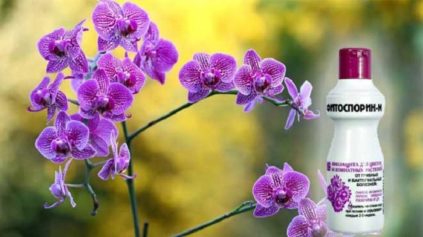 Before work, be sure to protect your hands with rubber gloves.During spraying and irrigation of the soil, the respiratory organs are protected with a respirator. At this point, do not eat, smoke or drink anything from the bottles. If the working solution was accidentally swallowed, then drink a large volume of clean water and try to induce vomiting. After that, 3 tablets of activated carbon are drunk.
Before work, be sure to protect your hands with rubber gloves.During spraying and irrigation of the soil, the respiratory organs are protected with a respirator. At this point, do not eat, smoke or drink anything from the bottles. If the working solution was accidentally swallowed, then drink a large volume of clean water and try to induce vomiting. After that, 3 tablets of activated carbon are drunk.
Important! For storage, the drug must be kept in a place where children or animals cannot reach it. It should be dry and not hot there
If a solution has already been prepared from the drug, it is stored in an airtight container, away from products or medicines.
To prepare the solution, use only clean and soft water. It is recommended to boil it or take melt water. The reaction of the liquid should be neutral or slightly acidic. You can assess the acidity using special paper tests sold in pharmacies.


